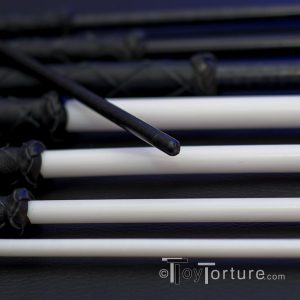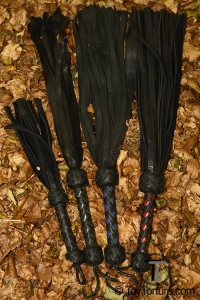Vendor: Jack’s Floggers
Construction
Today I am going to take a look at two sets of canes made by Jack’s Floggers which I have bought this summer. All canes are made the same way: At the bottom there is a grip section covered in braided black leather with a small knot on both ends so they look and feel a bit like a flogger. The bottom knot houses a steel ring so you can store the canes easily. The cane itself is a round rod with a rounded, deburred tip so there is no risk of unintentional injuries. The canes come in diameters of 6mm, 8mm, 10mm and 12mm. The delrin canes are black and 70cm long while the PTFE (more commonly known as Teflon) are white and 50cm long. The white fluoresces under UV lighting so accordingly lid play spaces this effect adds some extra visual drama to the scene. Sadly Jack’s Floggers only offer the canes in the mentioned length and does not offer short or longer ones even on request.
Playing with the Canes
The rule of thumb is: The thinner a cane, the stingier the impact sensation will be. However the two materials invoke a bit different sensations. The delrin is quite stiff and thus even stingier. Their sensation is closer to the one of “traditional” natural canes made out of rattan or wicker. Teflon on the other hand is way denser yet more flexible so the blows tend to be thuddier. The 70cm length of the delrin ones are a standard cane length which is ideal for playing with a bit of distance between the sub and the top ranging from the sub being fettered to a spanking bench to standing positions like on a St. Andrews Cross. The shorts Teflon ones are made for more intimate play like over the knee caning. The shorter length makes good targeting more important, especially when you want to hit both cheeks, thighs or sole of the feet. Since canes transfer a lot of kinetic energy onto a very small area, this kind of toy should be use with caution and experience and only on through muscles and fat tissue well padded body areas. Especially when doing bastinado (caning of the feet) or hitting hands (a practice commonly done in schoolboy scenes) do not use too much force. You might break the small and thus fragile bones. When it comes to marking both materials are in no way inferior to rattan or wicker.
I intentionally chose synthetic canes over natural ones for three reasons: First, synthetic ones are love maintenance. While you have to water or wax natural canes before playing to keep them flexible, I can spontaneously grab the synthetic ones in a scene and just use them. Second, unlike rattan they are completely smooth and have the same degree of flexibility on the entire length. Rattan’s internodes can effect flexibility and create a hard bulge in the middle of the cane which can inflict unintended and hard to control pain. Third and most important there is the saver sex aspect. Through the large amount of kinetic energy hitting the body, tissue fluid and in intense canings blood will cover the area in addition to sweat and abraded skin. Even polished and waxed wicker has a somewhat rough surface making it ideal for bacteria and viruses to linger and grow. So a natural cane should only be used on a single sub. Synthetic canes on the other hand can easily be sanitized and quickly be used again on a different sub.
I also chose the materials intentionally. Synthetic canes are made out of a number of different materials. Metal ones especially in combination with e-stim or heat/cool play are fun but in a high intensity scene hard to dose; they can actually shatter bones. Fibre glass or acryl can break in half or “just” spall causing nasty wounds which in case of fibre glass in some cases will never heal. Delrin and Teflon are basically unbreakable and will last you a lifetime.
| Conclusion: Well made and easy to use and maintain cane set. | ||||
| Pro | Cons | Where to get | Price | |
| Well made with artfully braided handle | Come only in fixed lengths | Jack’s Flogger | Set of 4 Delrin Canes: £50 | |
| Jack’s Flogger | Set of 4 Teflon Canes: £50 | |||
| Easy to sanitize | ||||
| Especially Teflon has unique sensation for a cane | ||||






